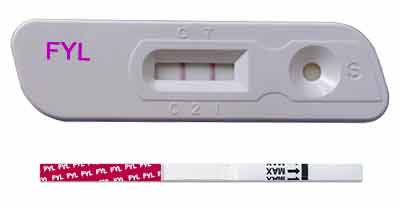Fentanyl Urine Test Kits
Fentanyl Rapid Test kit (Urine) is a rapid visual immunoassay for the qualitative, presumptive detection of Fentanyl in human urine specimens at the cut-off concentration of 200 ng/mL.

Principle of FYL Urine Test
FYL Rapid Test Strip (Urine) detects Fentanyl through visual interpretation of color development on the test strip. Fentanyl drug conjugates are immobilized on the test region of the membrane. During FYL testing, the specimen reacts with antibodies conjugated to colored particles and precoated on the sample pad. The mixture then migrates through the membrane under capillary action, and interacts with reagents on the membrane.
If there are insufficient fentanyl molecules in the specimen, the antibody-colored particle conjugate will bind to the drug conjugates on the testing region on the FYL test strip, forming a colored band at the test region of the membrane. Therefore, the development of a colored band in the test region indicates a negative fentanyl testing result.
If fentanyl molecules are present in the urine with a higher concentration than the cut-off of this FYL urine screening kit, they compete with the drug conjugate on the test region for limited antibody binding sites. This will prevent attachment of the antibody-colored particle conjugate to the test region. Therefore, the absence of a colored band at the test region indicates a positive fentanyl testing result.
The appearance of a colored band at the control region serves as a procedural control, indicating that the proper volume of specimen has been added and membrane wicking effect has occurred.
Reagents Used in FYL Test Strip
FYL Urine Test kit comes in both strip style and cassette style. Each fentanyl test device consists of a reagent strip. The amount of each antibody to fentanyl coated on the strip is less than 0.001 mg for antigen conjugates and goat anti-rabbit IgG antibodies, and less than 0.0015 mg for antibody components.
Fentanyl in Recreation Use
Fentanyl is a synthetic opioid related to the phenyl piperidines. Fentanyl is approximately 100 times more potent than morphine. This agent is highly lipid soluble, and can penetrate rapidly cross the blood-brain barrier. This is reflected in the half-life for equilibration between the plasma and cerebrospinal fluid of approximately 5 minutes for fentanyl. The levels in plasma and cerebrospinal fluid decline rapidly owing to redistribution of fentanyl from highly perfused tissue groups to other tissues, such as muscle and fat. As saturation of less well-perfused tissue occurs, the duration of effect of fentanyl and sufentanil approaches the length of their elimination half-lives of between 3 and 4 hours. Fentanyl undergoes hepatic metabolism and renal excretion. Therefore, with the use of higher doses or prolonged infusions, fentanyl becomes longer acting.
Cut-off of Drug Test Kits
| No. | Abbr. | Full Name | Cut-off (ng/ml) |
|---|---|---|---|
| 1 | AMP | Amphetamine | 1000 |
| 2 | BAR | SecoBarbital | 300 |
| 3 | BUP | Buprenorphine | 10 |
| 4 | BZO | Oxazepam Benzodiazepines | 300 |
| 5 | COC | Cocaine | 300 |
| 6 | COT | Cotinine | 200 |
| 7 | EDDP | ethylenediamine-dimethyl phosphinic acid | 100 |
| 8 | FYL | Fentanyl | 200 |
| 9 | K2 | Synthetic Cannabis | 50 |
| 10 | KET | Ketamine | 1000 |
| 11 | LSD | Lysergic acid diethylamide | 50 |
| 12 | MDMA | 3,4-methylenedioxy methamphetamine | 500 |
| 13 | MET | Methamphetamine | 1000 |
| 14 | MOR | Morphine | 300 |
| 15 | MQL | Methaqualone | 300 |
| 16 | MTD | Methadone | 300 |
| 17 | OPI | Opiates Morphine | 2000 |
| 18 | OXY | Oxycodone | 100 |
| 19 | PCP | Phencyclidine | 25 |
| 20 | PPX | Propoxyphene | 300 |
| 21 | TCA | Tricyclic Antidepressants | 1000 |
| 22 | THC | Marijuana | 50 |
| 23 | TML | Tramadol | 100 |

 Atlas Link Technology Co., Ltd
Atlas Link Technology Co., Ltd